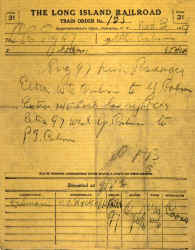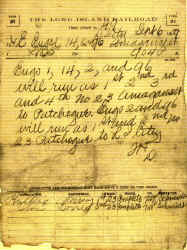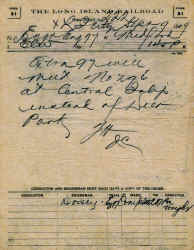All research/notes/photos depicted are from the archive of Dave Keller, unless noted otherwise.
Train orders were of two types: "31's," which
had to be signed for by the addressed "Conductor and Engineer"
(C&E), and "19's," which did not. The former were employed
when the dispatcher needed to know that the affected train actually had
the order, while the latter were used when he did not.
It
was gradually noticed that delivery of Form 19 was no less reliable
than the delivery of 31 orders. There was, however, one other matter
that had to be considered. When a conductor came to the block/train
order office, it was easy to make sure of the identification of his
train, so that the orders were delivered to the correct train. This was
not possible with 19 orders. Also, the train had to pass a train order
signal at stop when receiving 19 orders. The clearance card was already
in use to allow a train to pass the signal at stop. It showed the train
identification, and a list of the order numbers to be delivered to the
train ("I have ___ orders for your train.") The
engineman and conductor could check the clearance card to ensure that
they had the correct orders for their train.
The
setting up of meets between opposing trains had required 31 orders. At
least one 31 order was always required, and between extras, two. To
overcome this inconvenience, the dispatcher was permitted to use 19
orders to set up the meet, provided that he first sent a 19 order to the
operator at the station where the trains were to meet. This meant that
the order signal at the meeting station would prevent either train from
proceeding if either of the 19 orders failed to be delivered. This
proved an excellent idea, since it protected against train crews'
forgetting orders, and other contingencies, as well as non-delivery of
orders. The order sent to the operator at the meeting point was called a
"middle order."
As
evidence for the reliability of order delivery built up, it became
evident that there was really no need for the 31 order at all. Those few
cases where signatures were required could be handled simply by taking
the signatures on the 19 form. Some companies abolished the 31 order
completely, going back to the generic train order of the distant past
(but with different rules). Others kept the 31 form, but allowed the
free use of the 19 order in most cases.
Perhaps
the LIRR realized along with many other roads that these orders really
weren’t all that necessary after all because they discontinued their
use sometime after 1926. The below page from the 1925 Book of
Rules states the rule to display the red train order flag (for 31
orders) was annulled in 1939, however I've not seen a 31 order written
after 1926. . . It doesn't mean they didn't write them . . I just
haven't see any. Then again, the LIRR could've just not gotten
around to annul that red signal flag rule until someone brought it to
someone's attention that "Hey . . we haven't used these things
since 1926. Why don't we officially annul the rule?"
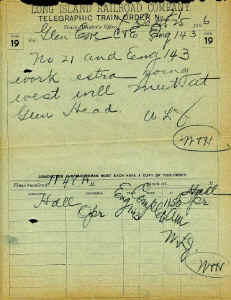
Form 19 - Glen Cove 9/25/1896
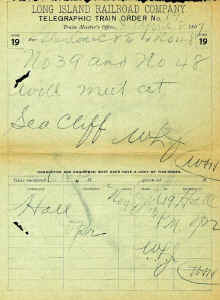
Form 19 - Glen Cove 4/08/1897
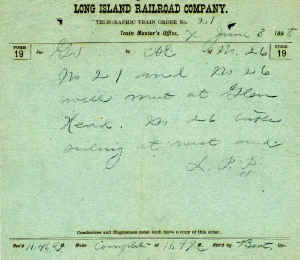
Form 19 - Glen Cove 6/08/1898
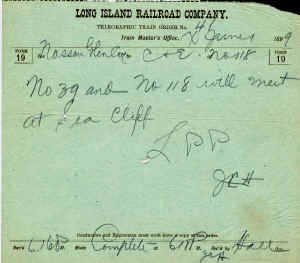
Form 19 - "GV" Glen Cove 6/01/1899
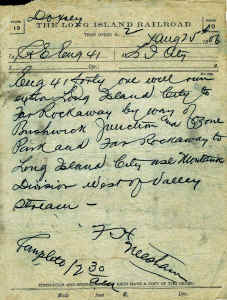
Form 19 - LI City - 8/25/1906
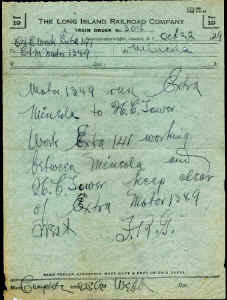
Form 19 - Mineola 10/22/1929
Note 1:
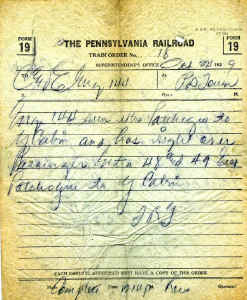
Form 19 - "PD" Tower 10/24/1929 (PRR Form)
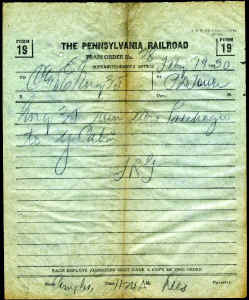
Form 19 - "PD" Tower Loco #35 2/19/1930
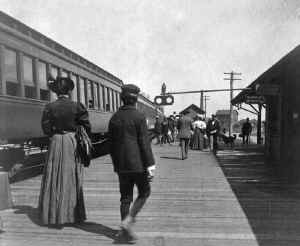
Train Order Signal - Bridgehampton View E c.1905 Archive: Art Huneke
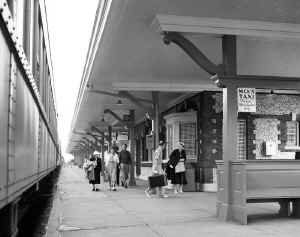
Southampton station at train time - View E - 06/20/1955
Note the T box (telephone box) at the far right hanging on the wall of the station building. A conductor would use the phone in this box to report clear after his train had taken the passing siding across from the depot and has cleared the main track for an oncoming train. (Will Faxon, Jr. photo, Dave Keller archive and data)
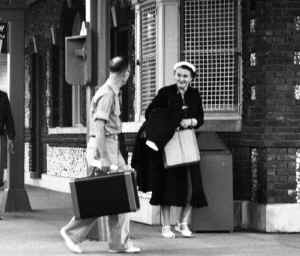
Southampton Station - Ticket bay and train order flag and lantern signal board Close-up 6/20/1955 (Will Faxon, Jr. photo / Dave Keller archive)
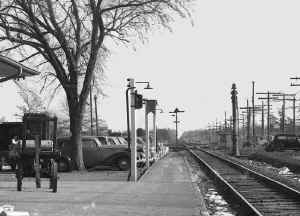
Train order signal flag displayed for eastbound train on first platform
light pole. Ronkonkoma
Station - View E 1/07/1944 (Weber-Morrison)
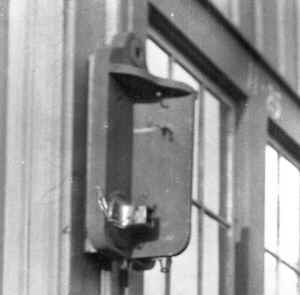
Train order flag and lantern board - Central Islip c. 1928 (George. G. Ayling photo, Dave Keller archive)
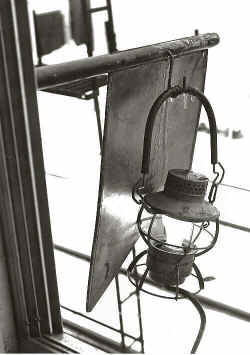 For
many years prior to flashing color train order signals located on the
position light mast, train crews were notified of train orders to be
picked up by a system of metal order boards and colored globe lanterns.
For
many years prior to flashing color train order signals located on the
position light mast, train crews were notified of train orders to be
picked up by a system of metal order boards and colored globe lanterns.
In
earlier years (prior to 1927) a red board was used to indicate form 31
orders were to be picked up and, as they needed to be signed for by the
conductor and engineer, they had to be distinctly different in aspect.
The last year of form 31 orders was 1926. After that, only yellow
boards were in use for form 19 orders.
The
order flag or order board was used in daylight applications and at
night, the board was hung with a lantern with matching globe (yellow for
form 19 orders and red for form 31 orders).
This
image shows a yellow train order board with lantern hung out at PD tower
in 1971. As it was a very gray, dreary, icy, wintry day, the board
AND the lantern were hung to further catch the attention of the engineer/conductor of the approaching westbound train and notify them that they
had orders to pick up.
The days of kerosene lanterns had long passed, so the train order lanterns were wired for use with a yellow electric light bulb.
Train order flag and lantern displayed at "PD" tower, Patchogue - 1972 (Dave Keller photo and archive)
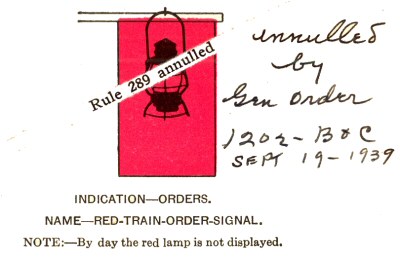
Form 31 order red flag
and lantern - 1925 PRR Book of Rules Archive: Art Huneke
The first initial
installation of semaphore signaling, I found, is from an 1880 ETT
description of Bedford Junction, opened in 1879. Research: Art Huneke
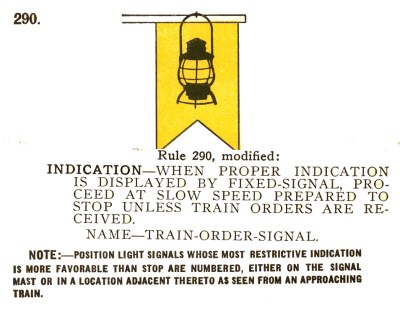
Form 19 order yellow flag and lantern
- 1925 PRR Book of Rules
Archive: Art Huneke
1925 PRR Book of Rules in use on the LIRR. A handwritten note states that the red flag and lantern were discontinued by general order, effective September 19, 1939. The last use of Form 31 orders was in 1926 and thus red was discontinued. It appears that it took 13 years for the railroad to scratch this signal indication from their rule books. According to the book of rules, the yellow order board was notched out at the bottom, while the red order board was square; most probably to catch the eye and not have any confusion over flags.
FORM 31
Form 31 train orders were issued at a block office and had to be signed by the receiving engineer and conductor. Like Form 19s, they gave instructions for the operation of the trains indicated. Also, their use was discontinued around 1926 or a bit later.
The
unattended block station signals, later block limit signals, were put in
place by the PRR in 1928 . . . AFTER the form 31s were no longer in use.
They were used in conjunction with the PRR's "K" clearance
cards, although train orders were still issued (Form 19s).
For more information: "READING A TRAIN ORDER FORM 31"
Form 31 9/06/1909 Archive: Art Huneke
A form 31 train order issued at the Dispatcher’s Office “X” in Long Island City and copied at the Medford train order office on September 9, 1909. A form 31 order differed from a form 19 order in that a form 19 order was caught on the fly by the train crew from train order hoops or sticks held up to the moving train by the operator. A form 31 order had to be signed by both the conductor and engineer at the train order office. This order was copied by operator E. C. Wright and signed by engineer Sylvester P. Doxsey . . .a well-know LIRR veteran. There was no conductor’s signature on this order as engineer Doxsey was operating 4-4-0 locomotive #97 light westbound through Medford. No conductor present in the cab . . . . only his fireman. Note the order was not addressed in its customary manner to “C&E No. ___” but, rather to “Engr. Eng 97.”
Form 31 9/09/1909
TRAIN ORDER SIGNAL
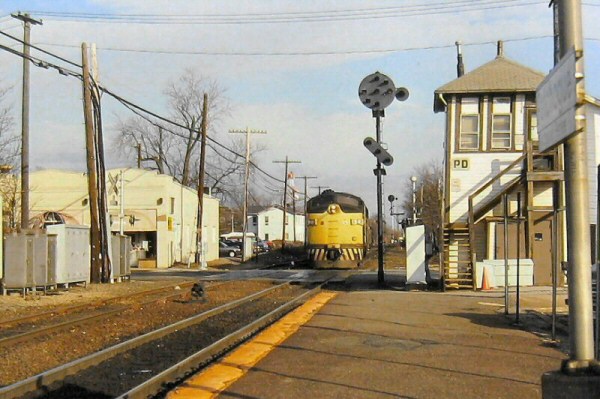
Here we have the Train Order Signal mounted
right side on the LIRR position light signal.
Photo: LIRR F-7A #622 HEP unit at "PD" Tower crossing
over to the North Siding for the westbound move. View E c.1992
Photo: Ebay
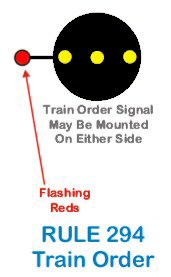 RULE
294: Train Order
RULE
294: Train OrderNOTE - By day the yellow lamp not displayed.
When displayed in the direction of an approaching train or trains, must not be passed by any such train on any track except as provided by Rule 221.
RULE 221: Movement by Train Orders
Unless otherwise provided on the time-table or by train order, a fixed signal must be used at each train order office which shall indicate Stop when there is an operator on duty, except when changed to Proceed to allow a train to pass after receiving train orders or for which there are no orders. A train must not pass the signal while Stop is
indicated.*
*Note: Rule 221 abridged by Steven A. Lynch
Source: PENNSYLVANIA
RAILROAD - RULES
FOR CONDUCTING TRANSPORTATION
OCTOBER 28, 1956
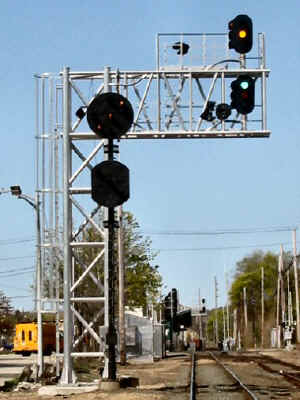
Position light signal on the left of track as there is no room for it on the right side of the track. Ocean Ave, Patchogue view W 4/29/2006 Train Order signal mounted left side.
Photo: Paul Strubeck
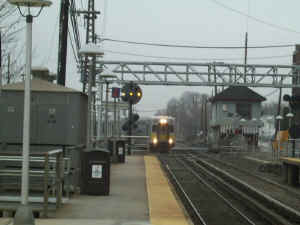
Nassau Tower - Mineola View E 4/12/01
Photo: Brian Weinberg
Left Train Order Signal mounted on mast and the right Train Order Signal on the signal face. Both inward toward trackside for visibility.
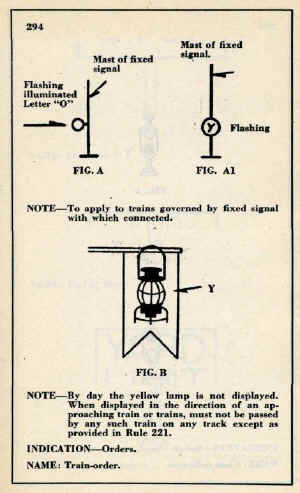
LIRR Train Order Signals - Book of
Rules - Effective 3/14/1954
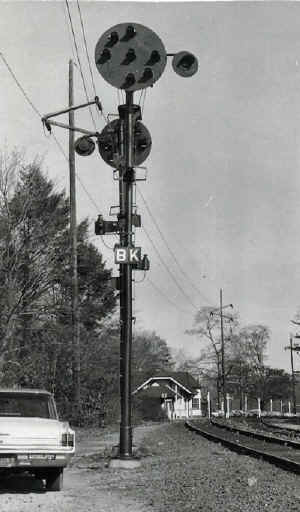
"BK" Tower - Stony Brook 1972 - Block Signals with Train Order signals mounted right
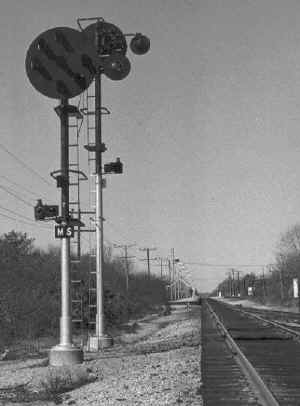
"MS" Tower Mastic Shirley 1970 - Block Signals with Train Order signals both mounted track side for visibility.
LIRR's Book of Rules eff. 07/01/66 for Block Signals and Block Limit Signals Definitions
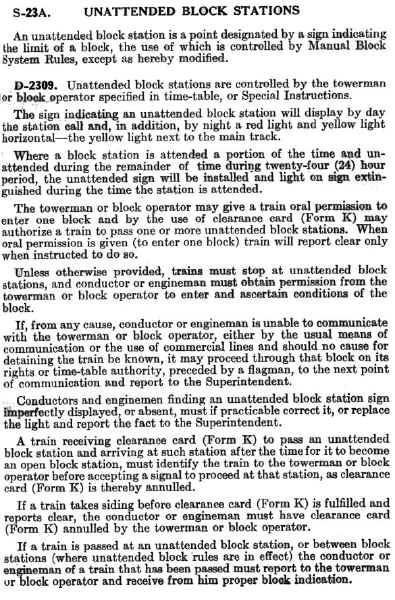 BLOCK
SIGNAL:
A fixed signal, or hand signal in the absence of a fixed signal, at the
entrance of a block to govern trains and engines in entering and using
that block.
BLOCK
SIGNAL:
A fixed signal, or hand signal in the absence of a fixed signal, at the
entrance of a block to govern trains and engines in entering and using
that block.BLOCK-LIMIT SIGNAL: A fixed signal indicating the limit of a block, the use of which by trains is prescribed by Manual Block Signal rules.
UNATTENDED BLOCK STATION SIGNAL: (See actual attached page (left) from the LIRR's ETT #110, eff. 06/16/1929. These went into effect on the LIRR the year prior (1928).
Unattended block station
signals were used when the manned block office was closed FOR THE DAY. Unattended
block station signals were mast-mounted lights that were turned on by
the operator when he shut the office down for the day. Not
all block offices were open 24/7. Only
the busy towers had 3 tricks.
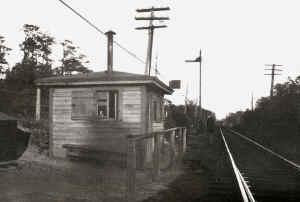
Typical cabin-style block office found all along the LIRR system for many years:
"Y"
Cabin with semaphore block signal - east of Sayville (end of double
track) View E c. 1925 (James V. Osborne photo, Dave Keller archive)
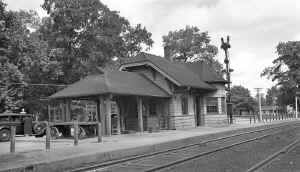
"BK" block station in the Stony Brook depot (View NE) 1937 Photo/Archive: (George E. Votava photo, Dave Keller archive)
BAY temporary block office. Westbound
M1 east of Bayside View E 4/12/78 (Madden-Keller)
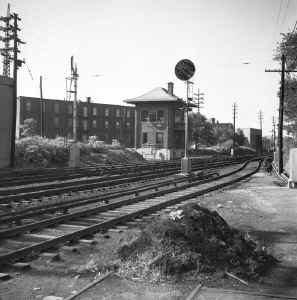
PARK Tower - Floral Park Semaphore and Position Light Signals View SW 10/12/1951 (Will V. Faxon photo, Dave Keller archive)
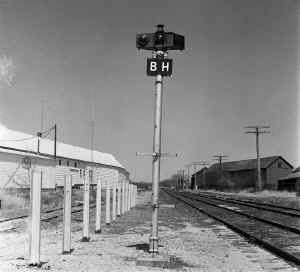
Bridgehampton "BH" Block Limit Signal View E 4/1970 Photo/Archive: Dave Keller
These
signals originally began as manned semaphore signals at manned block
offices. Then in 1928, when the PRR "K" card system went
into effect on the LIRR, they became "unattended block
station" signals for which went into operation when the block
operator was manually off duty and the block office closed for the day.
When
the block offices were eliminated these signals became "block limit
signals" and were controlled remotely by manned block offices that
were still in existence, such as "MS" (Mastic-Shirley) and
"PD" on the Montauk branch and "KO" (Ronkonkoma) on
the Main Line.
As
examples, unmanned signals along the Montauk branch in the 1970s and 80s
were BO, MO, PT, SK, WH, SN, BH, AG and MY.
When
station agencies were still open all the way out to Montauk, there were
more signals such as VN at Brookhaven, KH at Shinnecock Hills, WN at
Wainscott, WR at Watermill and HA at East Hampton.
For
example, see below for the evolution of the "MD" signal system
at Medford: 1910 shows the mast and semaphore signals.
1932 shows the unattended block signal lamps added lower down on the
mast. 1940 shows the mast truncated, doing away with the semaphore
signals and only the unattended block signal lamps in use. This
specific signal, by the way, was eliminated after the grade elimination
later in that year.
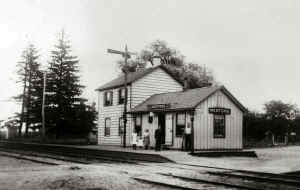
Medford Station semaphore block signal 1910 (Dave Keller archive)
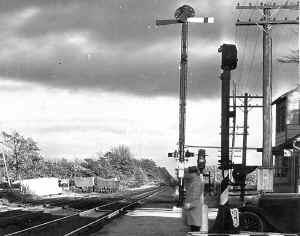
Medford Station "MD" Block Signal 11/10/1932
"MD"
(Medford) block signal (semaphore blades) and unattended block station
signal (lamps lower on the mast above the call letters)
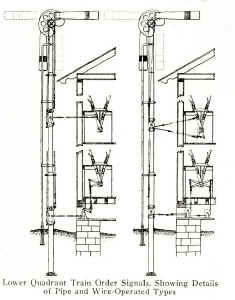
Lower Quadrant Semaphore Signals diagram details pipe and wire operated types
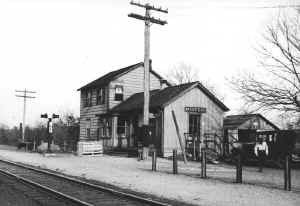
Medford Station "MD" Block Limit Signal (upper portion of signal mast removed) 4/1940 (Albert Bayles photo, Dave Keller archive)
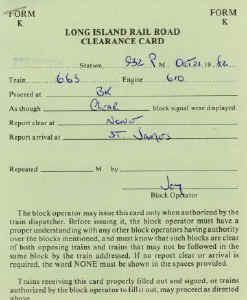 Also,
along with these signals, "K" cards issued by manned block
offices gave the trains addressed permission to pass these unattended
block station (and later, block limit) signals "as though clear
block signal were displayed."
Also,
along with these signals, "K" cards issued by manned block
offices gave the trains addressed permission to pass these unattended
block station (and later, block limit) signals "as though clear
block signal were displayed."
When train orders and "K" clearance cards were issued advising the conductor and engineer of a train that it was going to meet, the conductor of the train taking the siding to clear the main track would have to call in to the block operator who issued the order and report being "in the clear" so the train in the opposing direction could pass safely. "K" cards had a spot on them that said to "report clear at_____."
Form K ("K" card) 10/21/1982 Archive: John Volpi
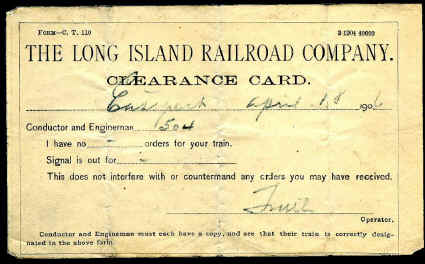
Clearance Card - Form C - Eastport 4/18/1906
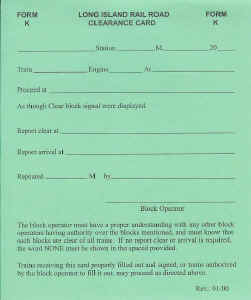
Card used in replacement of block signals in dark/manual block territory.
Archive: Paul Strubeck
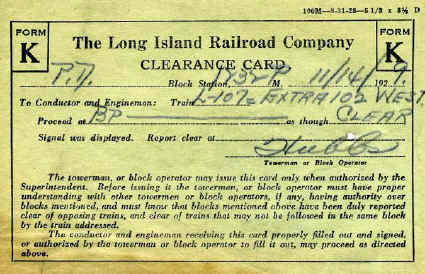
Form K - Clearance Card 11/14/1929
UNATTENDED BLOCK LIMIT SIGNALS
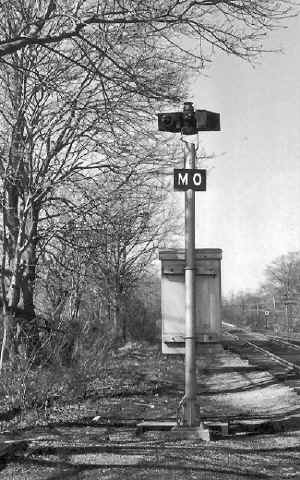
"MO" Block Limit Signal
Centre Moriches 1970
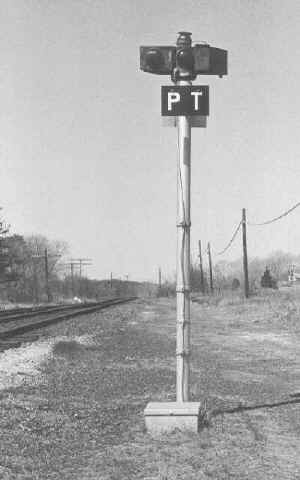
"PT" Block Limit Signal Eastport 1970
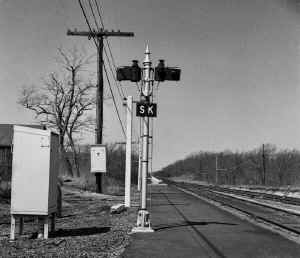
"SK" Block Limit Signal Speonk - T-Box View W 4/1970
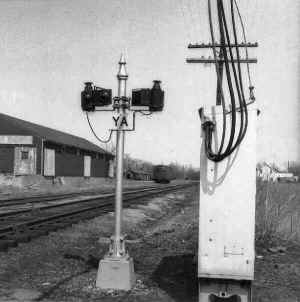
"YA" Block Limit Signal Yaphank 1968
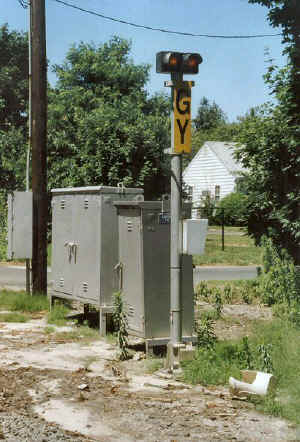
"GY" Block Limit Signal Greenport 7/2001
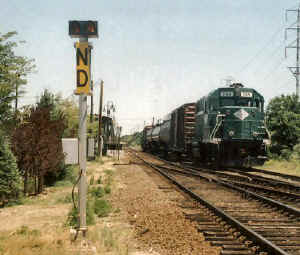
"ND" Block Limit Signal NYA #268 Hampton Bays 7/2001
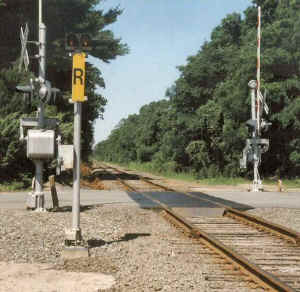
"R" Block Limit Signal Jamesport 7/2001
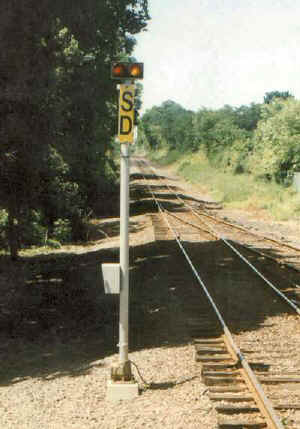
"SD" Block Limit Signal Southold 7/2001
GENERAL ORDER #101B, C, DATED 9/14/41: “UNATTENDED BLOCK STATIONS RE-DESIGNATED BLOCK-LIMIT STATIONS: EFF. 9/28/1941
